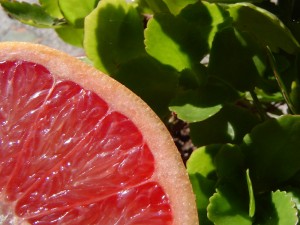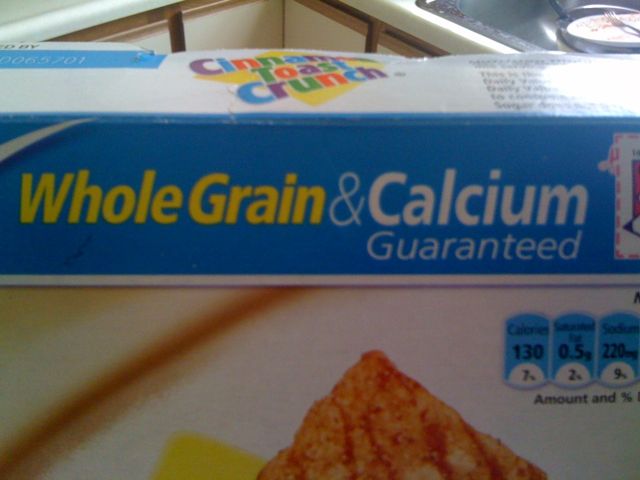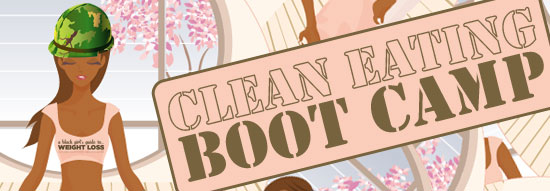When I first began eating better, I noticed a trend. I had less items to put in my pantry. Very little of my purchase went in the cabinets. My fridge? Overflowing. I was actually a little surprised. I didn’t know what was going on, but I wasn’t complaining.
Then, it hit me. The reason I needed less pantry and cabinet space was because I was buying live, unprocessed foods – foods that needed to be refridgerated and didn’t have some far-out expiration date. I was purchasing foods that could, inevitably, rot.

Live food – fruits and vegetables – have vitamins and minerals that originate naturally within the food as it grows from the ground. We want to take advantage of that. We want to ingest those naturally occurring vitamins and minerals. The cycle in which we participate calls for us to spread the seed of these fruits and vegetables, and the way those foods thank us for doing our jobs is by nourishing us. They have a direct reason for nourishing us and keeping us alive – without us, their seeds are not spread and they cease to exist, as well. This is why our bodies work best when we give them what is intended directly for them to enjoy.
Now that it’s clear that real food lives and dies, let’s talk about how we think a grocery store would go out of its way to keep real food alive.
Think about the architecture of your grocery store. Where do you find the freezers? Closest to the wall, right? What else do you find along the wall? Food that lives and, subsequently, dies. Dairy. Meats. Leafy greens. Potatoes. Kiwi. Tomatoes (mm… tomatoes.) Produce! Meats! Food.
Since real foods cannot be housed inside a little box with a far-away expiration date, it’s highly unlikely that you’ll find them in the aisleways. The good stuff that you’re looking for will almost always be as close to the wall as it can get. It’s basic common sense – it’s easier to keep the outermost parts of the grocery store colder than the innermost parts; the walls that house the refridgerators in the store are all going to be together, and they’ll be closest to the outsides.
Is this foolproof? Of course not. I’m sure you’ll see this in the fridges:

In case you can't see it, that says "pasteurized prepared cheese product," which is no different from "process cheese food," which is no different from "neon orange science experiment."
and, well, you might wince a little (it might be in your fridge right now!) but that’s okay. If you’re not careful, you can easily wind up with fake foods full of preservatives in your cart, or items sweetened with high fructose corn syrup. Be alert. This leads me to my second shopping tip: if it has a label, it’s probably not clean.
Think about it – what farmer is going to yank a batch of carrots out of the ground and slap a label on it? It doesn’t happen. It just… doesn’t happen. Real food doesn’t need a bright flashy label to prove its worth to you. Centuries of existence is good enough. The most beneficial foods – the foods best for you and your system – are often the foods with no advocates. They have no labels to tell you just how good they are. Evolution should teach you that.
Now, obviously, there are a few things that’ll slip through the cracks. For instance, extra virgin olive oil. Manufacturers are taking heed to the fact that more of us are using it (probably falling for that “Mediterranean Diet!” mumbo jumbo), and are loading it with stickers and star labels to promote the benefits of the oil. But more often than not, you’re going to find claims like this:
…and it’s not worth it. If you’re eating as close to the source, you’re not going to have to worry about calcium or “whole grains” (?) like that. (Though, if you’re a real stickler on your clean eating, you wouldn’t be eating as much whole grain as you think, anyhow.)
So if you’re buying a food that has a label, what should you look for? To me, it’s not about what you do see, it’s more about what you don’t want to see. That’s important. You don’t want a ton of ingredients making up what you’re eating… and if there are lots of ingredients, you want the list to look more like a recipe than a science experiment.
For this week of boot camp, we’ll be looking at how to shop, cook and eat clean. Thus far, you should be abstaining from fast food, cooking dinners at home (if you have processed foods, cook them so that they’re gone without wasting money) and drinking 8 glasses of water each day. This week, your goal is to plan out your food intake for each day before you go on. So tonight, before you go to bed, plan out your food for tomorrow. What will you enjoy as a snack? What will you have for dinner? Are you carrying breakfast with you out the door?
As we will be approaching the final leg of boot camp – grocery shopping – make sure you have enough money for one good grocery shopping trip for your household stored away. You’ll need it.
Are you a clean shopper? What tips and tricks do you use to keep your cart “clean?”



19 comments
I migrated towards cleaner shopping without really thinking about it. Jersey/Philly has the benefit of lots of Amish and farmer’s markets and those fresh from the farm foods are impossible to resist. It wasn’t until I started reading your site that I realized I was ‘clean shopping’. I generally shop the perimeter, only ducking in the aisles to get my seasonings, olive oil and whole wheat pastas (and making sure I bypass that damn cookie aisle).
And its true… my pantry is darn near empty. Fridge and freezer? Stuffed. But I’ve noticed that because of that, regular weekly grocery shopping has become our norm. If you don’t use it, it WILL go bad… like real food is supposed to do.
I’m definitely trying to shop a lot cleaner. I drive my girlfriend a bit crazy when we grocery shop because I am always stopping to read labels for the processed foods we buy (mainly pre-sliced cheese and lunch meat). We have practically eliminated all pre-packaged foods and are buying a lot more fresh produce. Not as clean as we could be but definitely on our way there.
I’ve been moving towards the clean eating since the beginning of this year. I, too, have noticed the empty cabinets and the additional cold items. The biggest adjustment has been that I have to accept that I’m going to be shopping for groceries more frequently. I have always tried to stick to a once-ever-two-weeks schedule, and the cleaner I eat – the more that concept goes out of the window. The more organized I am about weekly meal planning cuts some of this frustration down for me though. I am able to have needed items on hand and I do alot of prep work and cooking in advance, which saves time and money.
Thanks for the information. It helps to learn new things and to have my new “clean eating” convictions validated by your posts.
The most radical part of “clean shopping” that struck me the most is “if you don’t use it, it will go bad”.
Often times I found myself struggling to use the things I purchased but that’s when the fun started….recipe time!
*hint, hint, hint*
Food rotting is the downside of clean eating. Like buying an extra bag of string beans at the farmer’s market and finding that extra bag a week later behind the last cucumber and bell pepper, damp and with brown moldy spots. Or the green tomatoes I bought to fry that are now turning red on the windowsill. Or that extra head of red romaine that wilted while I was eating tomato/cucumber and black olive salads. Can’t salvage wilted lettuce. Wilted celery or carrots, or most other veggies you can put into a soup or broth. I put that wilted lettuce outside at night next to the garbage for the rabbits to eat( we have rabbits, possum, coon, pheasant, hawks and squirrels in our “urban prarie”), and they turned it down!
I had dinner with friends last week of fried green tomatoes, sauteed string beans with mushrooms and toasted pecans, rainbow salad: 3 colored peppers, cukes, 4 colored tomatoes, mozzarella, basil and white bass meuniere, and of course watermelon, ’cause I ain’t ashamed of admitting my love of watermelon. One of my friends told me she didn’t understand why she felt so good after eating so much. I told her it’s mostly fruits and vegetables, and everything was bought at the farmer’s market. We won’t be able to eat as cheaply like this come December, but that is what my freezer is for: to avoid eating that frankenfood found in the grocery store’s freezer department.
Now if only I could freeze watermelon…
I am only “spiritally” a black girl, however, I just love your site. In June of this year I stopped eating all meat and I need your imput and ideas. I guess I found you to late for boot camp but I will try to catch up. Thanks so much for all your hard work!
From the whitest girl you will ever know.
Interesting
I definitely noticed the difference between my pantry and fridge!
Something that I’ve found that helps fight food rotting is to buy fruits and veggies that are as good raw and alone as they are cooked and paired with things. If your red pepper looks like it’s close to going, chop it and eat it alone. It does mean that sometimes I eat the same thing a meal or two in a row, but I don’t waste food, money or nutrients.
I’ve been mostly staying on top of the vegetables by acknowledging that I would probably need more eggs or some yogurt (or the other 3 dairy products) sometime between buying cycles, and that I would get more veggies then.
Then there is letting the rotting veggies dictate my food choices for the week.
Then there is eating the rotten. As long as the white fuzzy patches on the tomato are small, the tomato can be deep-shaved with a knife before getting a thorough cooking. Same with a lot of plants that host white fuzz. I’ve even eaten a dead-smelling chicken, (though I wouldn’t feed it to anyone except myself and my husband,) and I did throw the liver into the bone-broth even though it’s usually my treat for dealing with a whole chicken.
Unfortunately it’s impossible for me to get my family to believe clean eating is not only better for us health wise, but financially as well. I’m a big girl, obviously, and I want to not only drop weight but avoid the type 2 diabetes that “runs in my family”, as well as asthma, high blood pressure, and cancer.
The cancer one may be unavoidable, but I know high blood pressure and Diabetes aren’t! The funny thing is that they know that. Also, my grandma recently started getting more into Doctor Oz, even though I was watching him for a year prior, and I told my grandma about all these health tips previously.
I seriously think I need to draw up some charts and graphs to prove this is a more cost effective way to eat. We’re on food stamps, and there’s three of us, so it’s hard to split the money and get nutritional foods without junk being thrown in.
Now, since I am working, one day a week, they expect me to have all this extra money to just give to them for bills. I use it to buy healthy food since after my first two weeks of work all I had was FAST FOOD. Ugh. Sorry for the negative Nancy rant lol. I’ve found a site dedicated to providing high quality, wholesome food to people of all economic status…and I’m definitely hitting it up soon. 😉
You inspire me. Keep going!
Several years ago I worked for a marketing strategy and research company and came across a story on grocery store marketing. Why things are placed where they are (eye level compared to lower on the shelves), the displays at the end of the isles, and how all the produce and perishables were along the outter isles. This was a big wake up call for me. Since then I rarely venture more than 2 isles inside the perimeter of the grocery store, I just dont need to. If I am inside picking up a canned item of some kind, I make sure to look at the whole section for that product. The more expensive and big names are at eye level, the “no name” brands or less expensive versions are often lower down. And those end of the isle displays, I only glance at as I walk by. I also now almost always go to self checkout where it’s 1 big open space and 4-6 tills. If I go to regular checkout I’m surrounded by tempting chocolate bars and soda waiting to grabbed as an impulse purchsae while in line.
Thank you. I’ve printed this and it’s now in my kitchen.
I surprised no one mentioned freezing! I freeze everything that I think I can’t use right away and other things I know I need to eat on the go. For example, I may eat oatmeal or greek yogurt & a fruit as my morning “snack” before I leave the house because I have a long commute. In the work freezer I keep: homemade organic turkey sausage (found a great recipe online), scrambled eggs (individual packaged), frozen mushrooms, and onions. I pop them in the microwave for a minute wrap it inside a whole wheat pita or English muffin with spinach, tomatoes & swiss cheese. Last month I bought too many strawberries. I cut them cut and frozen them. Added them to my water, green tea or just ate them as like a frosty treat. You can do the same with most fruits, veggies, & herbs. I’m using my frozen dill in a recipe tonight!
I did not know that it had a name, but I have been a natural shopper since college (I’m 32 now). I have always eaten home-cooked meals before leaving home and I just adopted those habits. By junior year and 30 pounds pounds heavier, I figured that something had to give. For instance, I let go buying hamburger helper and opted to use chopped tomatoes, good seasoning, bell peppers and onions to make the same dish from stratch and it tasted better. I can’t remember the last time I purchased boxed meals. As an adult, I am now finding ways to sustain the perishable foods that often times goes bad if I don’t get to eat them in time. Now I am practicing freezing meal portions, freezing chopped fresh uncooked vegetables, and freezing or blending all of my fruit into smoothing just before they are done. Great article! Thanks.
Best rule of humb I’ve ever found: if it didn’t grow out of the ground, or fall from a tree, or have a mother at sometime…don’t eat it!!
I’m trying to eat clean but I’m confused about different things. When I researched it some sites said don’t eat anything white. What about cheese? Dairy products?
If you’re not abstaining from dairy, cheese and milks can definitely be clean. Just have to be mindful of quality.
Comments are closed.